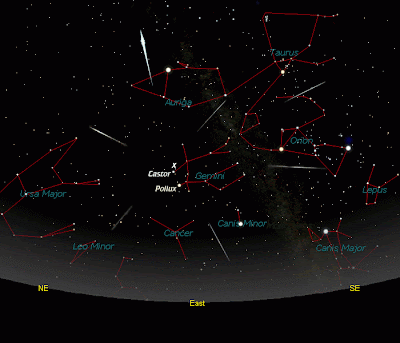Unfortunately due to the peak time at midday, the rate of meteors during the night won't be that high but you should be able to see meteors a couple of minutes apart on average.
The Moon will also be up obscuring some of the view, but later in the night the Moon will eventually set (roughly after 00:30) and you should be able to see more meteors.
During the peak shower (sadly not visible from Denmark due to the Sun being up) you should be able to see around 120 meteors per hour.
The Geminid shower is supposed to produce relatively slow moving and brightly burning meteors.
The shower will be appear to come from the constellation of Gemini (tvillingerne in Danish), which is visible in the south east at first and will move along towards the south west as the night comes along.
 |
| Image from astronomy.org |
The Geminids have been visiting us since December 7th and will stay with us until the 17th, so you might have noticed some meteors during the last week or so (I have).
As with the Perseids (in August), meteor showers are caused by the Earth moving through a tail of dust (usually) from a comet which passes near the Earth's orbit. The small dust particles are quite small and enter the atmosphere at high speeds with cause the small grains of dust to burn up high in the atmosphere producing those spectacular meteor showers.
In this case the shower is caused by the asteroid 3200 Phaethon. It isn't entirely clear how Phaethon has provided the dust (it doesn't have the usual tail of dust that comets have), but it is believed to be from with an impact with another object as Phaethon passes through the asteroid belt between Mars and Jupiter (not that likely) or (more likely) from the asteroid's very close proximity to the Sun during parts of its highly elliptical orbit.
The asteroid is thought to be an "extinct" comet having shed all its layers of ice during its many close passes of the Sun.
Anyway, if you happen to be outside tonight don't forget to look up. That's were all the cool stuff happens ;-)
0 comments:
Post a Comment